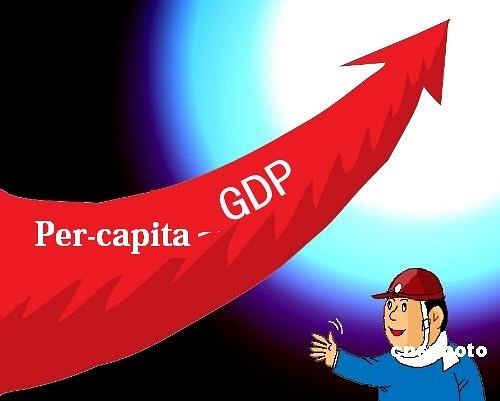
India needs Economic Growth, not redistribution
There isn’t much to redistribute anyways
GDP per-capita tells us that if the goods and services produced within the country are divided equally amongst its citizens, how much each citizen would get. It is a commonly used to compare the standard of living across different countries.The graph below shows where Indians stands in comparison to its neighbors since 1980.
The graph suggests that China and Maldives has a GDP per capita which is 240% higher than that of India. However, until 1991, both India and China had a similar GDP per capita but India fell behind.India does not match even Sri Lanka or a tiny landlocked country like Bhutan in terms of standard of living. They are not only ahead of us but growing faster than us. Until 2005, even Pakistan was doing better than India. This link can allow the readers to compare India’s performance with other countries.In the global context, in the year 2012, India stood at a low rank of 116th out of 160 odd countries for which data is available.
Worse still, India is falling behind. In his book, Transforming India, economist AtanuDey (PhD, UCLA) points out that in 1950s, both South Korea and India had similar per capita incomes. Today South Korea is 8 times richer than India. He also points out that the differences in prosperity levels between India and United States were lower during our grandfather’s generation than now. The GDP per capita of US is 16 times that of India, Australia’s GDP per capita is 12 times that of India and UK’s per capita GDP is 10 times that of India!
However, there seems to be a perception in the public discourse in India that India is sufficiently rich, but Indians suffer from poor standards of living because of the highly unequal distribution of goods and services. Hence, all is needed is some re-distributive mechanism through which the goodies can be transferred from the rich to the poor, from the urban areas to rural areas. The re-distributive nature of the policies implemented by the Congress led UPA have been framed and supported partly based on this illusion. These policies have not only been disastrous for the economy but were also misplaced because India simply does not have enough!
As shown above, even if all the goods and services produced within the country were distributed equally, Indians would still have abysmally low standards of living even in comparison to people living in neighboring countries. Therefore, India must focus on wealth creation rather than redistribution.
We need faster economic growth for yet another reason. We are surrounded by hostile neighbors and we need resources to defend ourselves. Dr. Vijay Kelkar, who headed the Thirteenth Finance Commission, suggested that the best foreign policy is for India to grow at 10 percent. This can give us an economic and political clout in the international community.
It is an empirical fact that people prefer higher GDP over lower GDP
The left leaning jholawalas want us to believe that to aspire for higher standards of livings is immoral. They often reject GDP as an indicator of human achievement and progress. They refuse to agree that more goods and services are good for citizens! They have come up with absurd alternative measures like Gross National Happiness (GNH) to defend their dangerous ideology.
They over-look the fact that it’s impossible to construct a reliable indicator which can be employed to compare the levels of happiness. Besides, even if GNH could genuinely compare levels of happiness across countries, this absurd measure has been rejected by the people. Indians value Gross Domestic Product over Gross National Happiness. This is evident from the fact that they migrate to countries like U.S., U.K. or Australia (countries with high GDP per capita) and not to Bhutan (where supposedly people are the happiest). It only goes to show the importance that the citizens of India (and other countries) attach to the availability of goods and services.
Given the preferences of people, the government should have tried to push the growth rates up by bringing in economic reforms. On the contrary, the economy was threatened with retrospective taxation, bureaucratic control and regime uncertainty. As a consequence,investment rates fell and the growth rates plummeted below 5 percent. Taxes in general went up in real terms. Even the poor, for whom the welfare schemes were ostentatiously designed, are taxed through inflation which remained at 10 percent levels for a long time.
Food inflation is close to a staggering 18 percent. Those below poverty line have suffered the most because food inflation hits the poor hardest. Rupee has significantly depreciated. There is a serious current account deficit and the country is finding it difficult to finance its imports. However, rather than owning responsibility for fiscal mismanagement, the Finance Minister is conveniently accusing people of buying gold!
Meanwhile, the Congress led UPA after sacrificing economic growth at the altar of populism continues to defend it policies of redistribution when there was nothing much to distribute!